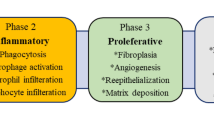Abstract
We studied the effects of Biopin ointment containing pine resin and used for the therapy of burns, wounds, and purulent and inflammatory diseases on the cell composition of wounds and histochemical changes in the granulation tissue during the therapy of extensive third-degree burns. The preparation stimulated the nonspecific immune response, normalized hemodynamics in damaged regions, and stimulated cell proliferation in the squamous epithelium.
Similar content being viewed by others
REFERENCES
B. M. Datsenko, Theory and Practice of Local Therapy of Purulent Wounds (Problems of Drug Therapy) [in Russian], Kiev (1995).
B. A. Paramonov and G. Sh. Mchedlidze, Therapy of Burns, Wounds, and Trophic Ulcers with Ointment Biopin [in Russian], St. Petersburg (2001).
B. A. Paramonov, Ya. O. Porembskii, and V. G. Yablonskii, Burns: Manual for Physicians [in Russian], St. Petersburg (2000).
Author information
Authors and Affiliations
Corresponding author
Rights and permissions
About this article
Cite this article
Khmel'nitskii, O.K., Simbirtsev, A.S., Konusova, V.G. et al. Pine Resin and Biopin Ointment: Effects on Cell Composition and Histochemical Changes in Wounds. Bulletin of Experimental Biology and Medicine 133, 583–585 (2002). https://doi.org/10.1023/A:1020290010605
Issue Date:
DOI: https://doi.org/10.1023/A:1020290010605




